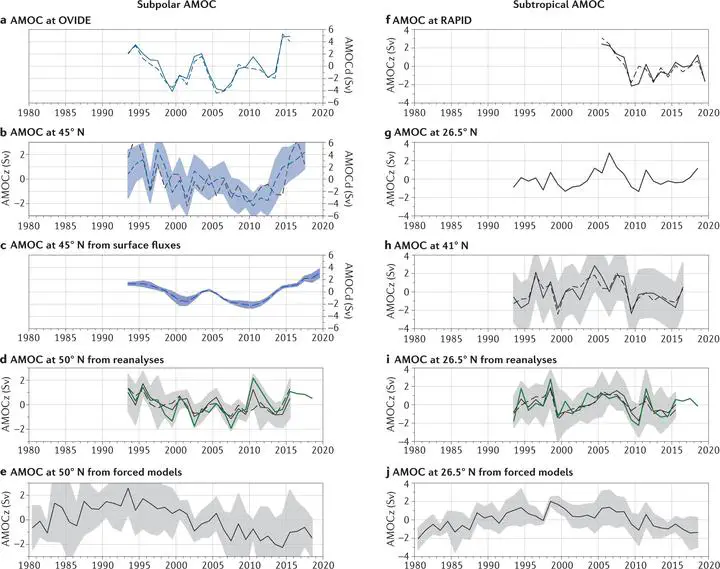The evolution of the North Atlantic Meridional Overturning Circulation since 1980
 Reconstructed Atlantic Meridional Overturning Circulation (AMOC) in the subpolar North Atlantic. Dashed lines indicate those timeseries wherein the wind-driven Ekman component is excluded. Shading indicates observational uncertainties (b, c and h), or twice the ensemble standard deviation (d, e, i and j).
Reconstructed Atlantic Meridional Overturning Circulation (AMOC) in the subpolar North Atlantic. Dashed lines indicate those timeseries wherein the wind-driven Ekman component is excluded. Shading indicates observational uncertainties (b, c and h), or twice the ensemble standard deviation (d, e, i and j).
Abstract
The Atlantic Meridional Overturning Circulation (AMOC) is a key component of the climate through its transport of heat in the North Atlantic Ocean. Decadal changes in the AMOC, whether through internal variability or anthropogenically forced weakening, therefore have wide-ranging impacts. In this Review, we synthesize the understanding of contemporary decadal variability in the AMOC, bringing together evidence from observations, ocean reanalyses, forced models and AMOC proxies. Since 1980, there is evidence for periods of strengthening and weakening, although the magnitudes of change (5–25%) are uncertain. In the subpolar North Atlantic, the AMOC strengthened until the mid-1990s and then weakened until the early 2010s, with some evidence of a strengthening thereafter; these changes are probably linked to buoyancy forcing related to the North Atlantic Oscillation. In the subtropics, there is some evidence of the AMOC strengthening from 2001 to 2005 and strong evidence of a weakening from 2005 to 2014. Such large interannual and decadal variability complicates the detection of ongoing long-term trends, but does not preclude a weakening associated with anthropogenic warming. Research priorities include developing robust and sustainable solutions for the long-term monitoring of the AMOC, observation–modelling collaborations to improve the representation of processes in the North Atlantic and better ways to distinguish anthropogenic weakening from internal variability.